"From the sky will come the Black Fortress.
From the Fortress will come the Slayers, to devour the planet of Krull.
Then shall a girl of ancient name become queen, and the king she chooses shall rule the planet."
Krull was licensed from the sci-fi/fantasy movie of the same name, directed by Peter Yates and released in 1983 by Columbia Pictures, who still owned Gottlieb at this time. The movie had a big budget of $25 million, a lot of which was spent on special effects. The cast were mostly lesser-known British actors, some of whom have become more famous since through other roles.
Columbia pictures had high hopes for the film and put a lot of money into promoting it. Gottlieb also showed plenty of ambition and put a lot of effort into the parallel development of both a pinball and video-game, with their release intended to coincide with the release of the film. It's important to note that this was a co-ordinated project, with the pinball and video-games being developed over an extended period (18 months in the case of the video-game) whilst the film was in production. It's for this reason, that the video-game is also covered here.
Gottlieb decided to kill the pinball for cost reasons before it could enter production. Only 10 complete games were produced as samples, making Krull a holy grail for System 80 collectors. Gottlieb's squirrel-tastic Goin' Nuts pinball suffered the same fate.
The Krull video-game (GV105), the first to be based on a movie, fared rather better with around 2'500 units being produced. Released in March 1983, programming was done by Matt Householder and Chris Krubel. Jeff Lee (Q*bert's creator) did the video graphics, David Thiel the sound, and Terry Doerzaph the cabinet graphics.
Like Haunted House, Krull featured 3 playfield levels, however the lower playfield was a self-contained unit with its own ball (same principle as Bally's Elektra). The lower playfield of Krull is inclined in the same was as the main playfield, unlike those of Haunted Houe and Black Hole, which slope away from the player. The ball moves betwen the upper and main playfields by way of ramps, through its own momentum, as on Spirit.
To understand the rules of Krull pinball (and video-game) a little better it helps to understand the plot of the film. On the planet Krull, the indestructible Beast and its legion of Slayers have attacked the newly formed kingdom brought about by the impending marriage of Princess Lyssa and Prince Colwyn. During the ceremony the Slayers attack, killing both kings, kidnapping Princess Lyssa and taking her to a black fortress that changes position each day. Prince Colwyn is injured but survives, and aided by the prophet Ynyr he recovers the legendary Glaive, a flying blade capable of phenomenal powers. With the Glaive in hand he sets off through the fantasy world to rescue Lyssa and defeat the Beast.
The upper playfield is home to the giant spider that guards the Widow of the Web. The layout is reminiscent of that of Williams' Black Knight. The ball shooter lane brings the launched ball directly onto the upper playfield, where the player has a pair of mini-flippers at his disposal. The features include, 4 drop-targets, a kick-out hole, a pop-bumper, a roll-over drop-target guarding a rollover, and a rollunder. A ball on the main playfield can reach the upper playfield up a ramp to the right or to the left. The left ramp access route takes the ball through a lane over another rollover.
The lower playfield represents the cave inside the Black Fortress, where the Beast guarding Princess Lyssa must be fought. The unseen Beast is lurking in his hole at the back, with 2 red lamp inserts marking its eyes. The lower playfield holds 1 ball that is automatically put into play by "outhole" kickers that are positioned behind and to the outside of the left and right flippers. The playfield features include a cluster of 3 spot-targets, 2 pop-bumpers, a turn-around rollover, a rollunder, a slinghsot and a kick-out-hole. It's difficult to make out what's happening on the lower playfield, as the player views everything through a Fresnel lens which serves not only to make things seem much smaller and further away than they are, but also distorts and obscures them.
On the main playfield, the most noticeable feature is the view to to the lower playfield through the Fresnel lens. A group of 5 white spot-targets are in the centre of the main playfield under the front edge of the upper playfield represent the 5 blades that must be collected by Colwyn to assemble the Glaive. There are 2 pop-bumpers, 3 slingshot kickers, an outlane and return lane rollover on either side, a side rollover and 3 flippers. The Black Fortress in the Iron Desert is depicted in front of the left-side ramp to the upper playfield. Either side of this ramp are single rollover drop-targets. The left one guarding a rollover, and the right a kick-out hole.
 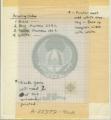  
Above, original pop-bumper and drop-target artwork showing the colour separations and below,
an original drop-target and pop-bumper cap decal sheet (photos: John Trudeau)

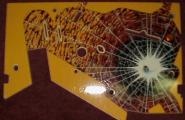   
NOS unpopulated upper, main and lower playfields set, and NOS lens window (photo: John Trudeau)
| 
Krull at Gottlieb
(photo: John Trudeau)
 
Krull from the front and closer up 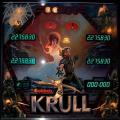
Backglass
 
Player's perspective of playfield
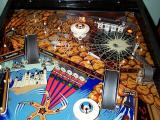
Upper playfield area

Lower area of playfield

Lower area of main playfield and close-up of lens insert

View through the Fresnel lens
(photo: John Trudeau)
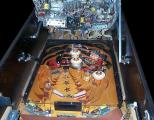
Lower playfield
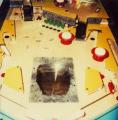
Krull whitewood
(photo: John Trudeau)
|
|

